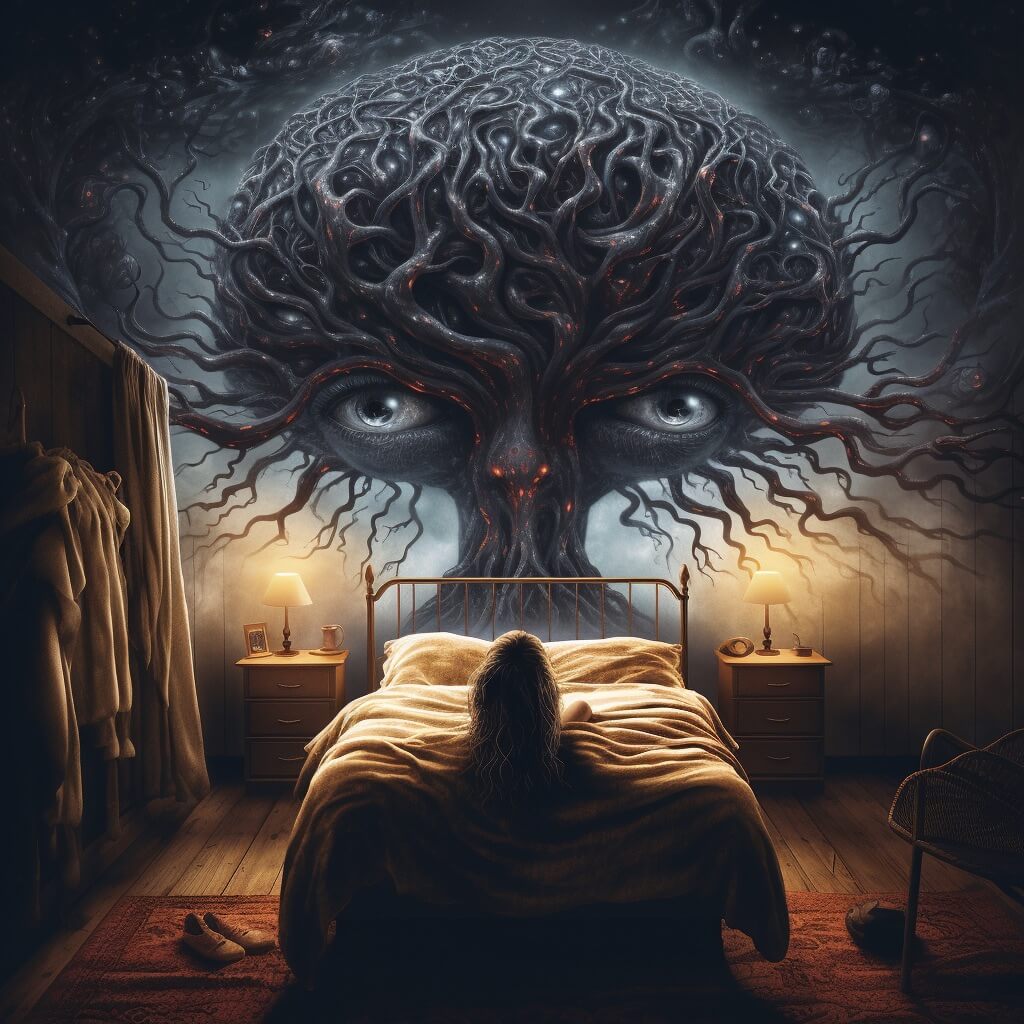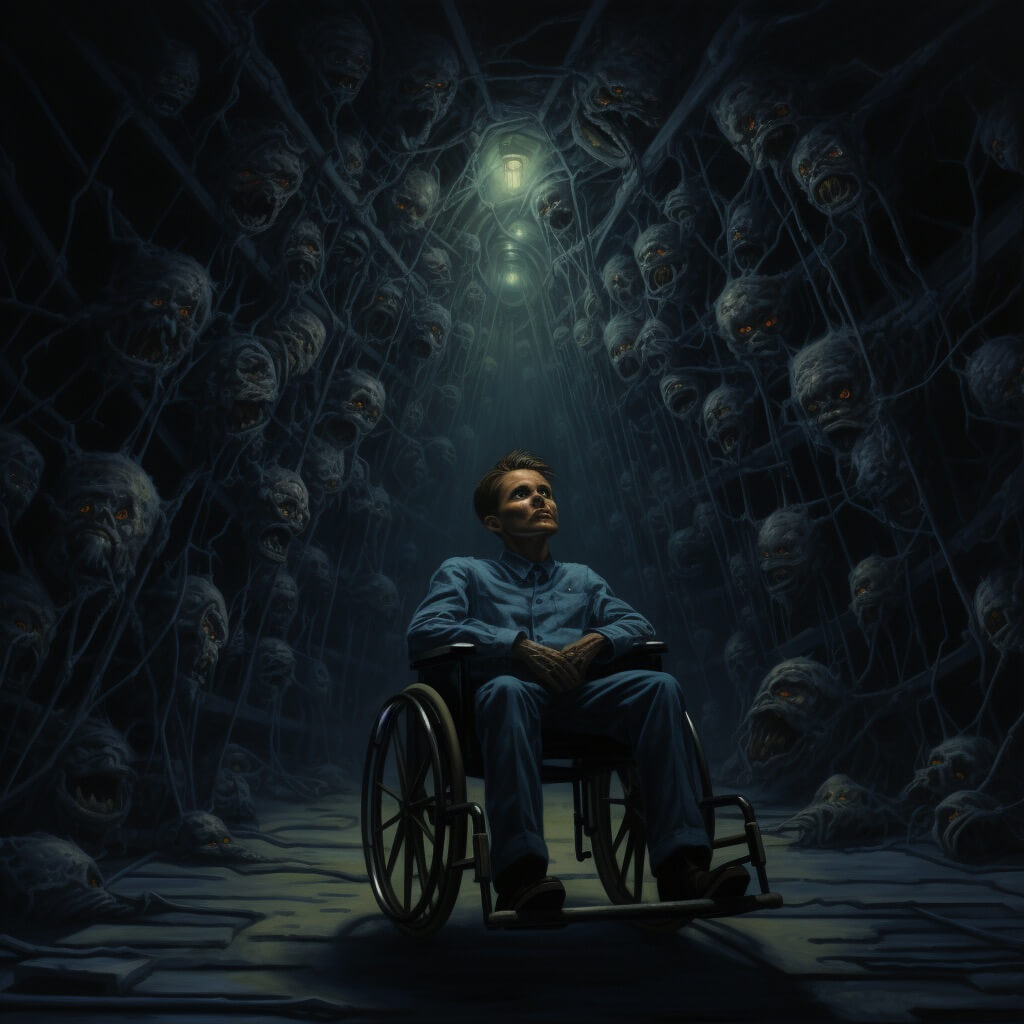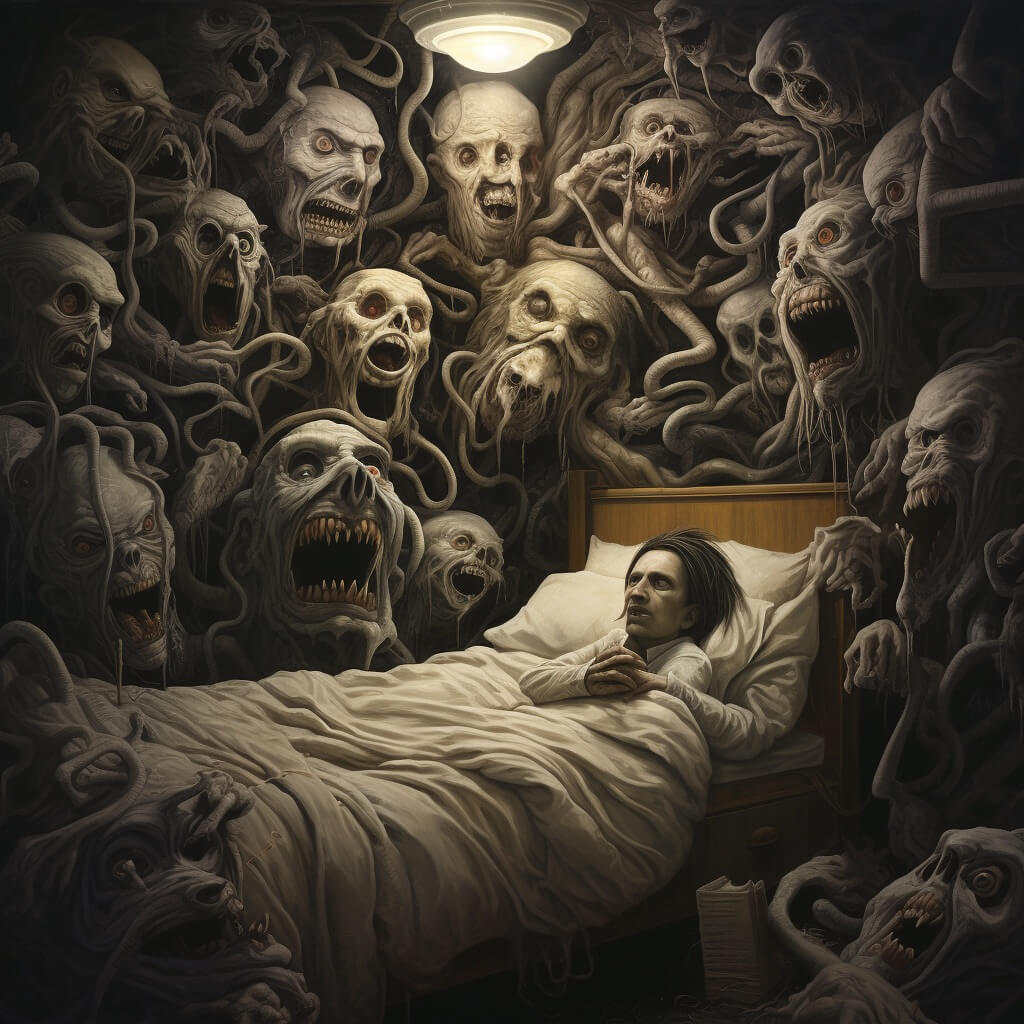In the silent depths of night, as the world outside succumbs to a tranquil hush, our inner realm occasionally stirs with tumultuous tales. These are not the whimsical dreams of flying or the joyous reunions with long-lost friends. Instead, they are the dark, foreboding narratives that grip our heart with fear, making our pulse quicken and our brow perspire. These are the nightmares, the shadowy counterparts to our more benign dreams.
Nightmares, with their eerie landscapes and unsettling scenarios, are more than just nocturnal disturbances. They are potent reflections of our deepest anxieties, unresolved conflicts, and sometimes, the echoes of traumatic events. Their impact extends beyond the fleeting moments of terror; they can disrupt our sleep quality, leaving us fatigued, wary, and on edge. More so, they can cast a lingering shadow on our emotional well-being, prompting introspection, unease, and a quest for understanding.
As we stand on the precipice of this enigmatic realm, let’s delve deeper, seeking to understand the mysteries of nightmares and the profound messages they bear. For in their dark folds might lie keys to our subconscious, waiting to be discovered.
The Nature of Nightmares

In the vast tapestry of the dream world, where myriad tales unfold, there exists a darker, more enigmatic weave. These are the nightmares, the stories that send shivers down our spine and make our hearts race in the quiet of the night.
The Essence of Nightmares Defined
Nightmares are dreams steeped in negative emotions, primarily fear, anxiety, or even horror. They aren’t just dreams with a slightly unsettling tone; they are intense, vivid, and often jarring experiences that can lea to abrupt awakenings and a lingering sense of dread. They are the nocturnal echoes of our deepest fears, manifesting in scenarios that might seem surreal yet feel profoundly real in the moment.
Distinguishing Marks: Nightmares vs. Regular Dreams
- Emotional Intensity: While regular dreams can span a range of emotions, nightmares are characterized by their heightened emotional distress. The feelings experienced are not just vivid; they are often overwhelming.
- Vivid Recall: Due to their emotional potency, nightmares are typically easier to remember upon waking. The distress they cause often imprints them more deeply into our memory.
- Physical Reactions: Nightmares can elicit strong physical responses, such as sweating, rapid heartbeat, or even trembling. Regular dreams, even if they evoke emotions, rarely result in such pronounced physical manifestations.
- Narrative Content: While regular dreams can be random or even mundane in their scenarios, nightmares often contain threats, dangers, or scenarios that evoke a sense of vulnerability or powerlessness.
In the grand spectrum of dreams, nightmares stand out with their dark allure. They beckon us not with their charm but with their mystery and intensity. Understanding their nature is the first step in unraveling their significance and learning to navigate their tumultuous waters.
The Science Behind Nightmares

Beneath the shroud of night, as our conscious mind retreats, a fascinating dance of neurons and brainwaves commences. This cerebral ballet, particularly during the REM phase, is the crucible where dreams and nightmares are forged. But what is it about this specific phase that gives birth to our most haunting nocturnal tales?
The Enigma of REM Sleep
REM, an acronym for Rapid Eye Movement, is a distinctive stage in our sleep cycle. As the name suggests, it’s marked by swift, darting movements of the eyes behind closed eyelids. But there’s more to REM than just these ocular dances:
- Brain Activity: Paradoxically, during REM, our brain’s activity mirrors that of our waking state. Neurons fire with vigor, and certain regions, especially those linked to emotions and memory, become particularly active.
- Bodily Paralysis: While the brain is aflutter with activity, the body enters a state of near-paralysis. This curious juxtaposition ensures we don’t physically enact our dreams or nightmares, keeping us safe from potential nocturnal harm.
The Nexus Between REM and Nightmares
The REM phase, with its unique brain activity and heightened emotional processing, is the prime stage for vivid, narrative-driven dreams. And here’s how it intertwines with nightmares:
- Emotional Amplification: The regions of the brain associated with emotions, like the amygdala, are especially active during REM. This can amplify the emotional content of dreams, giving rise to intense feelings of fear or anxiety, characteristic of nightmares.
- Memory Integration: REM sleep plays a role in integrating and processing memories. Traumatic or stressful events, when processed during this phase, can manifest as distressing dream scenarios.
- Safety Mechanism: Some theories suggest that nightmares, arising during REM, serve as a kind of rehearsal for potential threats. They prepare us, in a safe environment, to face real-world dangers.
The intricate dance of REM sleep, with its blend of heightened emotional and cognitive processing, sets the stage for nightmares. These haunting tales, while distressing, are a testament to the brain’s incredible capacity to process, integrate, and even prepare us for the challenges of the waking world.
Decoding Nightmares: What Do They Mean?

In the silent theater of the mind, nightmares are the dramatic plays that leave the audience—our waking selves—both captivated and perturbed. These tales, often draped in shadow and mystery, are not mere random disturbances. They bear messages, symbols, and insights waiting to be deciphered. So, what do these nocturnal narratives signify?
Common Themes and Their Echoes
Nightmares, despite their diverse scenarios, often revolve around certain recurring themes. These motifs, echoing across cultures and ages, offer a window into our shared human psyche:
- Being Chased: A universal theme, this often signifies feelings of vulnerability, evasion, or running away from unresolved issues in waking life.
- Falling: This can symbolize a sense of losing control, fear of failure, or even feelings of inadequacy.
- Trapped or Paralyzed: Such dreams might reflect feelings of entrapment, be it in a situation, relationship, or even one’s own fears.
- Losing Teeth: Often linked to concerns about appearance or fear of helplessness, this theme might also signify a loss of power or transition in life.
- Unpreparedness: Dreams of appearing for an exam without preparation or being on stage without knowing one’s lines can mirror anxieties about unmet expectations or fear of public judgment.
The Psyche’s Mirror: Psychological Significance
Nightmares, especially recurring ones, are like mirrors reflecting our inner world. Their repetition often indicates unresolved emotions, traumas, or anxieties:
- Processing Trauma: Nightmares can be the mind’s way of processing traumatic events, trying to make sense of them or seeking closure.
- Highlighting Anxieties: Persistent nightmares might be signaling underlying anxieties or stressors that need attention in our waking life.
- Confronting Repressed Emotions: Sometimes, emotions or desires we suppress find their voice in nightmares, urging us to confront and acknowledge them.
- Warning Signals: On occasion, nightmares serve as warning signs, highlighting unhealthy patterns, relationships, or situations that might be detrimental.
By seeking to understand and decode these dark tales, we not only demystify them but also gain profound insights into our emotions, fears, and desires. They beckon us not to be feared but to be understood, for in their depths lie keys to our innermost self.
The Root of the Fear: Why Do We Have Nightmares?

In the silent corridors of sleep, nightmares emerge like ghostly apparitions, casting their eerie glow upon our resting minds. But from where do these phantoms arise? What conjures them from the depths of our psyche?
To understand the genesis of nightmares, we must delve into the intricate interplay of psychological, physiological, and environmental factors.
The Mind’s Abyss: Psychological Triggers
- Unresolved Traumas: Past traumatic events, whether recent or from distant memories, can resurface in the form of nightmares, reflecting the mind’s attempt to process and heal.
- Stress and Anxiety: Periods of heightened stress or chronic anxiety can manifest as distressing dreams, mirroring our inner turmoil.
- Repressed Emotions: Emotions or desires that we push into the subconscious, whether out of fear, societal norms, or personal beliefs, can find their voice in nightmares.
- Life Transitions: Major life changes, such as moving, job transitions, or the loss of a loved one, can trigger nightmares as the mind grapples with the new reality.
The Body’s Whispers: Physiological Causes
- Medication Side Effects: Some medications, especially those affecting neurotransmitters, can lead to vivid and sometimes distressing dreams.
- Substance Withdrawal: Withdrawal from substances like alcohol or certain drugs can disrupt sleep patterns, leading to nightmares.
- Sleep Disorders: Conditions like sleep apnea or restless leg syndrome can interrupt the sleep cycle, increasing the likelihood of nightmares.
The World’s Echo: Environmental Factors
- Late-night Snacking: Consuming heavy or spicy meals before bedtime can increase metabolism and brain activity, potentially leading to vivid dreams or nightmares.
- Traumatic Events: Exposure to traumatic events, even indirectly through media, can induce nightmares as the mind processes the shock.
- Sleep Environment: Factors like an uncomfortable sleeping position, fluctuating room temperatures, or even eerie sounds can influence the nature of dreams.
In the intricate web of factors that give birth to nightmares, one thing becomes clear: they are not arbitrary or capricious entities. They are reflections, echoes, and sometimes, reactions to our inner and outer worlds.
By understanding their roots, we not only demystify these nocturnal tales but also gain a deeper understanding of the myriad forces shaping our dreamscapes.
Nightly Terrors: Why Some Experience Nightmares Every Night

In the vast cosmos of dreams, where stars of hope twinkle and galaxies of memories swirl, there exists a dark nebula. This is the realm of recurrent nightmares, where the same haunting tales play out night after night. But why do some of us find ourselves trapped in this loop of nightly terrors? And what toll does this relentless cycle exact on our mental well-being?
The Labyrinth of Recurrence: Potential Reasons
- Post-Traumatic Stress Disorder (PTSD): Individuals who’ve experienced traumatic events, be it a natural disaster, assault, or a harrowing accident, may relive these traumas in their dreams, leading to recurrent nightmares.
- Chronic Stress: Persistent stress, whether from work, relationships, or other life situations, can manifest as repetitive nightmarish scenarios, reflecting the mind’s continuous state of turmoil.
- Sleep Disorders: Conditions like insomnia or narcolepsy can disrupt the natural sleep cycle, making individuals more susceptible to recurrent nightmares.
- Past Emotional Wounds: Unresolved emotional pain or conflicts from the past can keep resurfacing in dreams until they’re addressed or healed.
- Environmental Triggers: Consistent exposure to distressing stimuli, such as disturbing movies, books, or even news, can imprint on the mind, leading to repetitive nightmarish themes.
The Shadow’s Toll: Implications on Mental Health
- Sleep Deprivation: Recurrent nightmares can lead to frequent awakenings, resulting in fragmented sleep. Over time, this can lead to chronic sleep deprivation, affecting cognitive functions, mood, and overall health.
- Heightened Anxiety: The dread of impending nightmares can induce a state of anticipatory anxiety, making individuals apprehensive about sleep.
- Emotional Exhaustion: Reliving distressing scenarios night after night can lead to emotional fatigue, making individuals more susceptible to mood disorders like depression.
- Avoidance Behavior: To escape the cycle of nightly terrors, some might resort to unhealthy coping mechanisms, like substance abuse or avoiding sleep, which can have detrimental effects on overall well-being.
In the echoing halls of recurrent nightmares, every shadow, every whisper carries a message. They beckon for understanding, healing, and sometimes, intervention. Recognizing the reasons behind these nightly terrors and their implications is the first step towards breaking the cycle and reclaiming the sanctity of peaceful slumber.
Navigating the Night: How to Prevent and Avoid Nightmares

The realm of nightmares, with its shadowy alleys and haunting whispers, might seem like an inescapable labyrinth. Yet, with the right tools and knowledge, one can chart a path towards more serene nocturnal journeys. The key lies in understanding the triggers and adopting practices that foster peaceful slumber.
Laying the Foundations: Establishing a Healthy Sleep Routine
- Consistency is Key: Going to bed and waking up at the same time every day, even on weekends, helps regulate the body’s internal clock, promoting better sleep quality.
- Crafting the Sanctuary: Ensure your sleeping environment is conducive to rest. This includes a comfortable mattress, optimal room temperature, and minimal light and noise disturbances.
- Dietary Considerations: Avoiding caffeine, nicotine, and heavy meals close to bedtime can reduce the chances of disrupted sleep and nightmares.
- Limiting Screen Time: The blue light emitted by phones, tablets, and computers can interfere with the production of melatonin, a hormone that regulates sleep. It’s advisable to limit screen exposure at least an hour before bedtime.
The Art of Relaxation: Techniques to Ward Off Nightmares
- Mindful Meditation: Engaging in mindfulness practices can help calm the mind, reducing anxieties and stresses that might manifest as nightmares.
- Deep Breathing Exercises: Techniques like the 4-7-8 method, where one inhales for 4 seconds, holds the breath for 7, and exhales for 8, can induce a state of relaxation, preparing the body for restful sleep.
- Progressive Muscle Relaxation: This involves tensing and then relaxing different muscle groups in the body, promoting physical relaxation and reducing bodily tensions that might influence nightmares.
- Guided Imagery: Visualizing peaceful and calming scenarios can set a positive tone for the night’s dreams.
- Aromatherapy: Scents like lavender or chamomile have been known to promote relaxation and improve sleep quality.
In the quest to prevent and avoid nightmares, the journey is as much about understanding oneself as it is about adopting beneficial practices. By fostering a harmonious sleep environment, both internally and externally, one can navigate the night with greater ease, turning the tide against the shadows of nightmares and embracing the embrace of peaceful dreams.
The Paralysis in the Dark: Understanding Sleep Paralysis Nightmares

In the liminal space between wakefulness and slumber, there exists a phenomenon as mystifying as it is unsettling: sleep paralysis. A state where the body is immobile, yet the mind is acutely aware, often accompanied by nightmarish visions. This paralysis, though transient, can leave an indelible mark on one’s psyche. But what is this enigmatic occurrence, and how can one navigate its eerie grasp?
Sleep Paralysis Unveiled
Sleep paralysis is a temporary inability to move or speak while falling asleep or upon waking. It occurs when the brain awakens from the REM (Rapid Eye Movement) phase, but the body remains in its paralyzed state, a natural mechanism to prevent us from acting out our dreams. This dissonance between the conscious mind and the immobilized body creates the unique, and often terrifying, experience of sleep paralysis.
The Nightmarish Visions of the Paralyzed
During these episodes, individuals might experience hallucinations, which can be:
- Intruder Hallucinations: A feeling that there’s a malevolent presence in the room, often perceived as a shadowy figure or an entity.
- Chest Pressure Hallucinations: A sensation of being pinned down, choked, or suffocated, as if a weight is pressing on one’s chest.
- Vestibular-Motor Hallucinations: A feeling of floating, flying, or out-of-body experiences.
These visions, combined with the inability to move, create an atmosphere of intense fear and vulnerability.
Shining Light on the Shadows: Managing Sleep Paralysis Nightmares
- Awareness: Understanding that sleep paralysis, though terrifying, is a harmless phenomenon can reduce the fear associated with it.
- Sleep Hygiene Maintaining a regular sleep schedule, ensuring a comfortable sleep environment, and avoiding sleep disruptors like caffeine can reduce the frequency of episodes.
- Stress Management: Stress and anxiety are known triggers. Incorporating relaxation techniques like meditation or deep breathing can be beneficial.
- Sleep Position: Some studies suggest that sleeping on one’s back can increase the likelihood of sleep paralysis. Shifting to a side-sleeping position might help.
- Professional Guidance: If episodes become frequent or severely distressing, seeking the counsel of a sleep specialist or therapist can offer tailored strategies and insights.
By understanding its nature and adopting strategies to manage it, one can transform these nightmarish episodes from harrowing ordeals into mere footnotes in the grand narrative of one’s nocturnal journeys.
Whispers from the Dreamworld: Unraveling Nightmares’ Mysteries

The realm of nightmares, with its intricate tapestries of fear and wonder, often leaves us with questions. These enigmatic nocturnal tales, while perplexing, hold answers that shed light on our psyche, our fears, and the very nature of dreaming. Let’s delve into some of the most frequently asked questions about nightmares.
Why Do Nightmares Occur During REM?
The REM (Rapid Eye Movement) phase of sleep is a unique stage characterized by heightened brain activity, akin to that of wakefulness. It’s during this phase that most of our vivid, narrative-driven dreams occur. The brain regions associated with emotions, especially the amygdala, are particularly active during REM. This heightened emotional processing, combined with the brain’s attempt to integrate and make sense of our experiences, can give rise to nightmares. In essence, the REM phase provides the perfect backdrop for these intense emotional tales to play out.
How Can I Reduce the Frequency of My Nightmares?
Reducing the frequency of nightmares often involves a combination of lifestyle changes and addressing
underlying triggers:
- Sleep Routine: Establishing a consistent sleep schedule helps regulate the body’s internal clock, promoting
better sleep quality. - Relaxation Techniques: Practices like deep breathing, meditation, or progressive muscle relaxation can help
alleviate stress, a common trigger for nightmares. - Sleep Environment: Ensuring your sleep space is comfortable, dark, and quiet can foster more restful sleep.
- Addressing Underlying Issues: If nightmares are a result of trauma or unresolved emotional issues, therapy or
counseling can provide tools and insights to process these emotions. - Limit Stimulants: Reducing the intake of caffeine or nicotine, especially close to bedtime, can improve sleep
quality and reduce the likelihood of nightmares.
Are Sleep Paralysis Nightmares Dangerous?
While sleep paralysis nightmares can be profoundly terrifying, they are not physically harmful. The sensation of paralysis is a natural protective mechanism to prevent us from acting out our dreams. However, the psychological impact can be significant, especially if these episodes are frequent. It can lead to sleep anxiety or even a fear of sleeping. While not dangerous in a physical sense, if sleep paralysis nightmares are affecting one’s mental well-being or quality of life, seeking professional guidance or counseling is recommended.
In the intricate dance of dreams and nightmares, understanding is our most potent ally. By seeking answers and embracing knowledge, we can navigate the night with greater confidence, transforming our nocturnal journeys from paths of fear to odysseys of discovery.
As we traverse the intricate pathways of sleep, the realm of nightmares stands as a testament to the mind’s profound depths. These nocturnal tales, while often shrouded in fear and mystery, are more than mere disturbances. They are mirrors reflecting our anxieties, hopes, traumas, and even our uncharted desires. By seeking understanding, embracing knowledge, and adopting strategies, we can transform our relationship with these nightly narratives. Instead of fearing the dark, we can learn to dance with its shadows, turning each night into a journey of discovery and healing.

